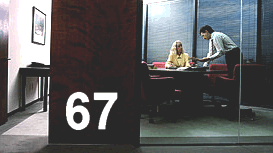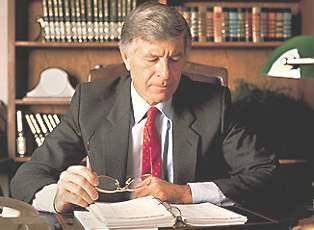Module 67 |
|
Legal and
In this final section on legal and ethical issues we'll cover:
Staging Staging applies to ENG and documentary work and involves the alteration of a scene, or the broadcast or reenactment of a news event, without telling your audience. The motivation for staging can range all the way from an attempt to enhance the look of a scene to a blatant attempt to alter the truth. If staged footage is broadcast and is found to represent an effort to misrepresent the truth, it can result in fines by the Federal Communications Commission (FCC), a lawsuit by an offended party, and a loss of credibility for a news organization-not to mention severely damaging your professional status. No matter what your personal feelings are, present situations and viewpoints as honestly as possible. "Truth" is easy to defend; slanting a story is not. Although the latter route may be tempting, in the long run it opens the door to all kinds of legal, ethical, and professional problems. At the same time, ratings and profits often influence TV
production content--even to the point of "crossing the line" in these areas. There
are some important things to consider in this |
|
For example, if you are covering "the handing over of the gavel"
to This allows camera people to light the scene as they want, make sure no people are blocking camera angles, and arrange people so they can all be clearly seen. It is doubtful that the public expects authenticity in this type of situation. But, there are other times when the public assumes they are seeing "the moment." If you reenact a critical moment in sports history when someone breaks the world hi-jump record and you don't bother to inform your audience that what they are seeing is actually a warm-up or a reenactment, it's an entirely different matter. Question: is it unethical to simply enhance a scene by removing distractions on a desk, moving a coat rack out from behind someone's head, or setting up your own special lighting? Although "purists" might argue that you are "tampering with the truth" if you change anything in a scene, most videographers routinely do these things when they see a need. The dividing line is whether you are enhancing a scene for the
sake of clarity and technical quality, or distorting the truth. Using Comparable Footage A related issue is the use of comparable footage, video that appears to be the event being reported, but is from an earlier time or even from a different place. For example, you might be tempted to cut in some unused scenes from yesterday's forest fire to illustrate today's story on the same fire. Some would say, "A fire's a fire, what's the difference?" Well, there is a difference, and the FCC has taken a dim view of this kind of substitution-unless the fact is made quite clear to the audience. Simply keying the phrase "file footage" or an earlier date over the footage will suffice.
Music, photo illustrations, drawings and published text are copyrighted and cannot be broadcast or reproduced for distribution without clearance or permission from the copyright holder. Under 1998 copyright revisions, copyright now extends for the life of an artist or individual copyright holder, plus 70 years. Copyrights owned by corporations are valid for 95 years. However, in 2004, these time periods were under review.
For example, these TV production materials are protected by international copyright law and can only be used directly from the Internet from either CyberCollege.com or InternetCampus.com. Although they legally can't be copied or used for commercial purposes, one non-democratic country reproduced the materials for its own purposes and, in the process, deleted references to freedom of the press. (One disgruntled person in that country brought this to our attention.) Sometimes, especially in the case of noncommercial television, permission to use copyrighted materials will be granted without charge, or for on-screen credit. More typically, a fee must be paid to the copyright holder. But, to protect yourself and your company or institution, make sure you get the permission in writing. In the case of videos, you can feel reasonably safe using copyrighted material that will be viewed only by family members or a small group of people where no admission is charged. However, if you are producing the video for broadcast or distribution, or you intend to enter the piece in a video contest that is giving away prizes, you'll need permission to use copyrighted material, plus a signed talent release from on-camera principals. More on that later. Text, photos, film, or video produced by the U.S. federal government do not fall under copyright restrictions unless they were done by an outside agency that used copyrighted material. It's best to check.
The fair use act allows copyrighted material to be used in limited ways for criticism, teaching, scholarship, news, or research without the permission of the copyright holder. Unfortunately, the fair use act is not well defined. We'll only get a clearer picture of what constitutes fair use after a number of court cases have addressed the issue. Many assume-we would hope, accurately-that under this act small portions of copyrighted work can be used for a limited time for criticism, teaching, scholarship, news, or research, as long as this use doesn't appreciably affect the income that could be derived from the work by the copyright holder.
A work is in the public domain when its copyright has expired. (As we've noted, under that 1998 act, copyright extends for the life of an artist plus 70 years, and copyrights owned by corporations run for 95 years.) Although many old music selections are in the public domain, you need to watch out for recent arrangements of older works that have come under new copyright restrictions.
Obtaining clearance to use a copyrighted music selection normally involves getting performance rights, mechanical rights, and synchronization rights.
Are you confused? Then you definitely have been paying attention, because the process is confusing. What most producers do is turn the whole thing
over to an agency like the Harry Fox Agency in New York, which was founded by the
National Music Publishers Association. It's important to note that the standard performing rights license that a broadcast station typically pays for does not normally cover the use of music in commercials, public service announcements, and productions. You need to check your license carefully to see what it does and does not cover. If you are producing video for a non-profit or charitable organization, you may be able to get permission to use a music selection for free or for a token one-dollar fee. If this is what you are doing, be sure to mention it when you contact one of these agencies.
Since music clearance is complex and cumbersome, many people opt for audio libraries that include a wide variety of musical selections and sound effects. These can be purchased on CDs. Once the library is purchased, you can use the material over an extended length of time for most production purposes. This generally means the music comes with a master use clause that includes mechanical, synchronization, and performance rights. Material in these libraries has been written or selected with the needs of the video and film producer in mind. With titles like "Manhattan Rush Hour," and "Serenity," you immediately know the nature of the musical selections. One of the largest collections of sound effects, featuring some 2,500 effects on 60 CDs, is the BBC Sound Effects Library. Under "Cars," for example, you will find sound effects such as windshield wipers, horns, various engines, a car stalling, doors slamming, windows opening, seat belts snapping, and a car skidding. Under "Babies" you will find crying, hiccups, gurgling, laughing, bathing, babbling, coughing, first words, singing, and tantrums. Many postproduction houses put sound effects on their editing server. When an effect is needed, they just go into a master listing, find what they want and recall it instantly. Thanks to digital electronics, each of these effects can be modified in endless ways to more perfectly meet needs-speeded up, slowed down, filtered, and even reversed.
To get around many of the problems in the use of recorded music many producers prefer original music. The advantages include.
If the music is relatively simple
(possibly a guitar, flute or organ), or it's electronically synthesized (which most
music is today), original music can be produced rather inexpensively. In the hands
of an expert, a music synthesizer can create the sound of anything from a single
instrument to a full orchestra. There are many groups that will compose original music for productions
(for a price), including This Internet site, aimed at digital video producers, offers copyright-free music.
We noted in Module 66 that using someone's "likeness" (a photo or a video of them) without their permission can get you into legal trouble-unless the video is shot in a public place. By having the person sign a talent release
or a model release you can be granted the permission you
need. This step protects videographers in case the people involved later decide
they don't want the footage broadcast, or want extra compensation. Here is a
It may come as a surprise that you
may need a release to use some locations in a video. For example, you could not
use a well-known amusement park as a setting for your commercial video without the
permission of the property owner. Thus, we also have Bear in mind that the "once over lightly" treatment of the legal issues in these modules is only designed to alert you to possible danger areas. Law libraries have thousands of books on these areas, and there is still great uncertainty about what's legal and what isn't. About the only thing we know for sure is that lawsuits are very expensive for all parties involved, and the best defense is no offense. |

 a newly-elected officer during a meeting, you will frequently find that the people
involved often expect-maybe even prefer-to do the whole thing over again afterwards
for the media.
a newly-elected officer during a meeting, you will frequently find that the people
involved often expect-maybe even prefer-to do the whole thing over again afterwards
for the media.
 This
agency serves as an information source and clearing house for music-licensing matters.
When you get in touch with them, make sure you have all the information at hand
on the specifics of music you want to use.
This
agency serves as an information source and clearing house for music-licensing matters.
When you get in touch with them, make sure you have all the information at hand
on the specifics of music you want to use.